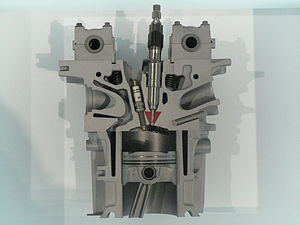
Back محركات الحقن المباشر للبنزين Arabic Директно впръскване Bulgarian پڕژێنەری ڕاستەوخۆی گازۆلین CKB Zážehový motor s přímým vstřikováním Czech Direkte benzinindsprøjtning Danish Benzindirekteinspritzung German Otsesissepritse Estonian تزریق مستقیم بنزین Persian Suoraruiskutus Finnish Injeksi langsung bensin ID
Gasoline direct injection (GDI), also known as petrol direct injection (PDI),[1] is a mixture formation system for internal combustion engines that run on gasoline (petrol), where fuel is injected into the combustion chamber. This is distinct from manifold injection systems, which inject fuel into the intake manifold (inlet manifold).
The use of GDI can help increase engine efficiency and specific power output as well as reduce exhaust emissions.[2]
The first GDI engine to reach production was introduced in 1925 for a low-compression truck engine. Several German cars used a Bosch mechanical GDI system in the 1950s, however usage of the technology remained rare until an electronic GDI system was introduced in 1996 by Mitsubishi for mass-produced cars. GDI has seen rapid adoption by the automotive industry in recent years, increasing in the United States from 2.3% of production for model year 2008 vehicles to approximately 50% for model year 2016.[3][4]
- ^ "House of Lords - Merits of Statutory Instruments - Twenty-Fifth Report".
- ^ Alfred Böge (ed.): Vieweg Handbuch Maschinenbau Grundlagen und Anwendungen der Maschinenbau-Technik. 18th edition, Springer, 2007, ISBN 978-3-8348-0110-4, p. L 91
- ^ "Draft Technical Assessment Report:Midterm Evaluation of Light-Duty Vehicle Greenhouse Gas Emission Standards and Corporate Average Fuel Economy Standards for Model Years 2022-2025" (PDF). 19 August 2015. Archived (PDF) from the original on 12 August 2016.
- ^ "Light-Duty Automotive Technology, Carbon Dioxide Emissions, and Fuel Economy Trends:1975 Through 2016" (PDF). www.epa.gov. Archived from the original (PDF) on 17 November 2017.
